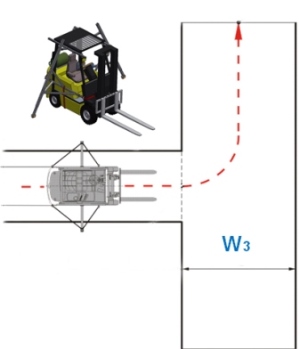KANBrief 2/16

Over 8,000 accidents involving fork-lift trucks occur in France every year. Of these accidents, around 560 result in permanent incapacity for work, and four to six – when trucks tip over to the side – are fatal. The figures for Germany are similar (pdf, in german) (pp. 70 ff). The INRS (Institut National de Recherche et de Sécurité (France)) and the BGHW (German Social Accident Insurance Institution for the trade and distribution industry (Germany)) have compared the stability gains delivered by driver assistance systems on fork-lift trucks with the requirements of EN 16203.
In recent years, several fork-lift truck manufacturers have developed driver assistance systems (DAS) that are intended to reduce substantially the risk of the truck tipping over to the side. However, the test method of EN 16203:2014 (Safety of Industrial Trucks – Dynamic tests for verification of lateral stability – Counterbalanced Trucks), which is used to test the stability of fork-lift trucks weighing up to five tons, fails to provide precise information on the stability limits of the vehicle, nor does it permit conclusions regarding the performance or efficacy of the driver assistance system. The test method does not therefore enable the most to be made of the fork-lift truck manufacturers' most recent innovations.
INRS and BGHW develop test programme
The INRS and the BGHW have jointly developed and conducted a test programme for the evaluation of driver assistance systems. The test method is based upon that of the standard referred to above. A test run is conducted in which a 90-degree bend is negotiated at full throttle. The standard specifies a certain aisle width at the exit of the bend according to the maximum speed and the dimensions of the truck. The driver must negotiate the bend three times without making contact with the track barriers and without the inside rear wheel lifting off. The efficacy of the driver assistance systems was tested by progressive reduction of the aisle width in steps of 50 cm until the driver of the truck was no longer able to meet the test criteria. For safety reasons, the fork-lift truck was fitted with outriggers (see figure above).
Following a request made to European fork-lift truck manufacturers, driver assistance systems from Still, Jungheinrich, Toyota, Linde and Hyster were included in the study. 11 models frequently used in companies were tested, with rated payloads of between 1.6 and 2.5 tons, three or four wheels, and powered by an internal combustion engine (gas or diesel) or electric motor. The top speeds lay between 15 and 20 km/h.
How do driver assistance systems work?
The majority of driver assistance systems limit the speed of the fork-lift truck according to the angle of lock in the bend. The technology was first used on electrically powered models, since the power can be controlled instantaneously more easily on these models. More recently however, it has also become available for fork-lift trucks with internal combustion engines. On four-wheel fork-lift trucks, other types of driver assistance system available briefly lock the rear swing axle or influence its behaviour. Of the test vehicles, eight electric trucks and one truck with an internal combustion engine featured cornering speed adjustment. Two fork-lift trucks with internal combustion engines used a mechanism acting on the rear swing axle. Two electric four-wheel fork-lift trucks combined both solutions.
Results
The test results (see diagrams) show the stability limit of each fork-lift truck at a given top speed (correctly negotiated minimum aisle width W3): the lower the value of W3, the higher the stability of the fork-lift truck. The stability limits specified in the standard are shown by an unbroken black line. The stability of the fork-lift trucks was found to be considerably greater than that required by the standard. The most stable were three-wheel electric fork-lift trucks with a maximum speed below 17 km/h and on which the speed-limiting effect increased as the bend became tighter. The particular safety benefit offered by driver assistance systems is that they can substantially reduce the risk of tipping as a result of excessively high cornering speed.
A further stability criterion that was recorded was how often in the four last and therefore most demanding test runs the inside rear wheel lifted off the ground during cornering. Five of the eleven fork-lift trucks tested completed these four final runs without lifting of the rear wheel off the ground being observed. The most stable four-wheel fork-lift trucks are those with a combination of speed reduction in bends and locking of the rear axle (Conception innovante de béquilles latérales pour chariots élévateurs […]. INRS, Note Scientifique et Technique N°342. Mai 2016).
The results are being used firstly in order to encourage revision of the stability limits in the standard, and secondly to encourage users to select safer products.
Jérôme Rebelle Marcus Gaub
jerome.rebelle@inrs.fr m.gaub@bghw.de